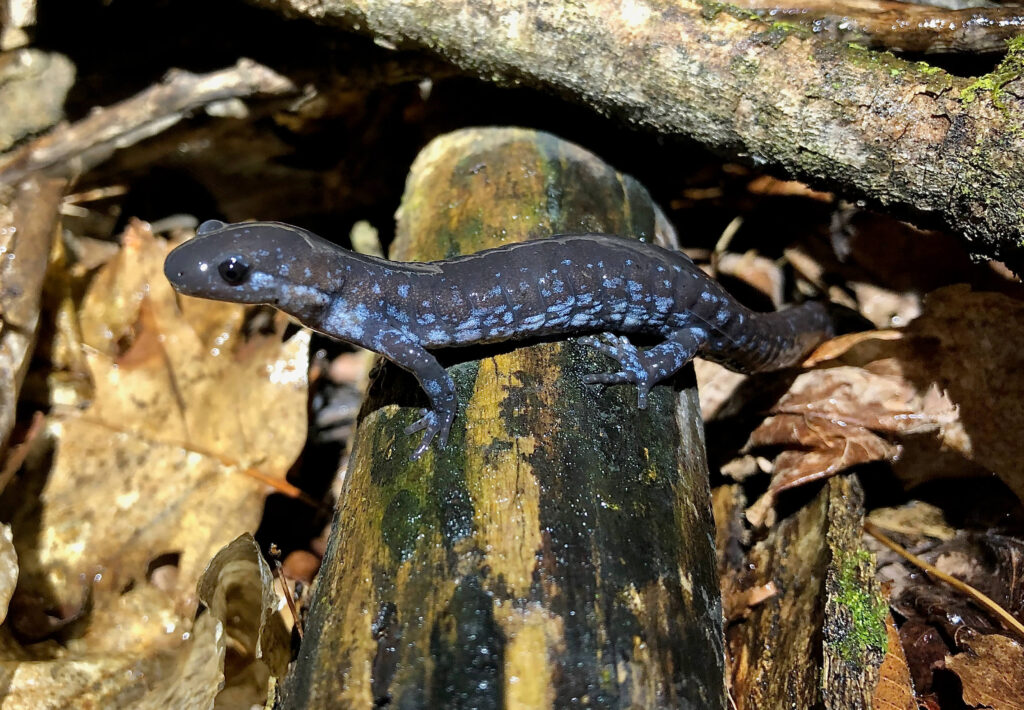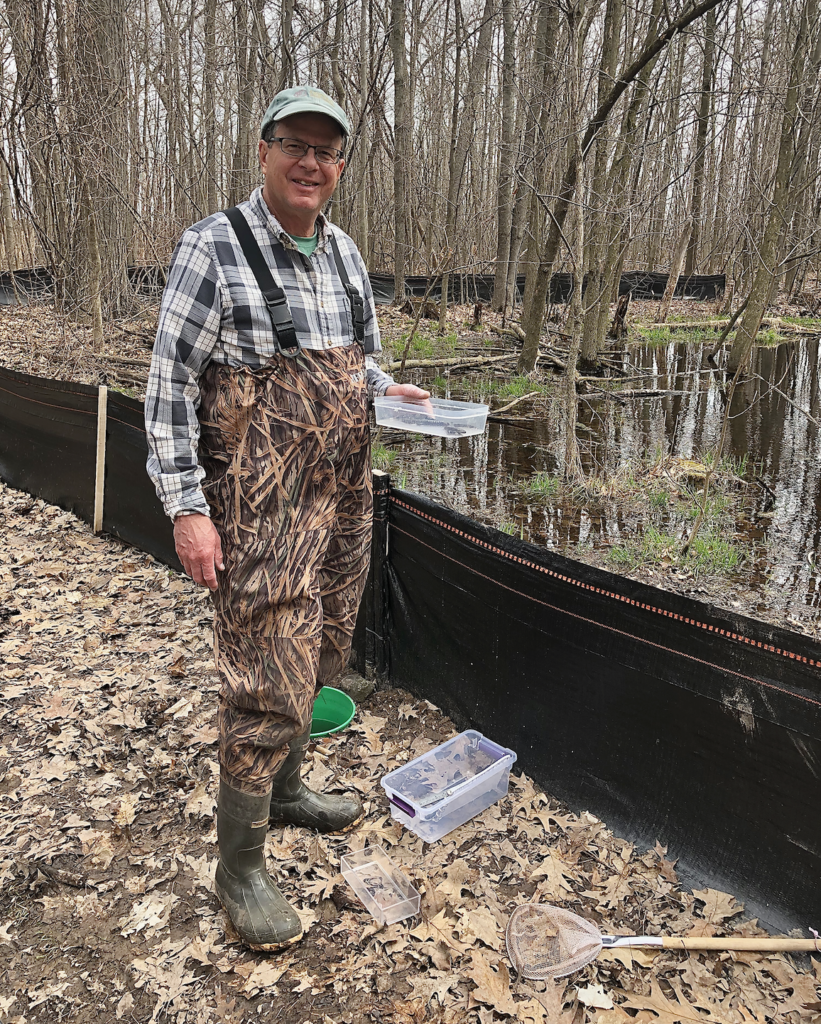Greg Burns always had a passion for nature, and was excited to spend his retirement immersed in the outdoors. Little did Burns know he would come to uncover a unique salamander living quietly in the forests of Central Wisconsin.

In the cool beginning of spring when the lilacs start blooming and the spring peepers begin to sing, a young boy would venture into the woods to search the ponds for anything that moved. He found wonder in the stripes on a turtle’s neck and the small dark places where tadpoles liked to swim. He grew up to be Greg Burns, a Master Naturalist, citizen scientist, and retired healthcare executive.
Much of Burns’s childhood was spent building connections with nature. Whether it was looking for frogs or tending to turtles in his backyard, Burns developed an enduring affection for the outdoors that would stay with him for the rest of his life.
While Burns worked in healthcare management for close to 40 years, he wove nature into his life by traveling to the Northwoods each year to canoe camp with his children. In retirement, Burns became a volunteer and field assistant with many environmental organizations, including the Wisconsin Odonata Survey, the Bald Eagle Nest Watch (BENW), Snapshot Wisconsin, and Cooper’s hawk research. He is also a board member of the Friends of High Cliff State Park.
These organizations offered Burns the opportunity to survey and interact with many of Wisconsin’s plants and animals. Burns’s relationships with these organizations started simply: he expressed his interest, and they readily welcomed him to their work.
“They’ve been very encouraging and supportive and excited about this research because it enables them to have people on the ground to do this research, which they otherwise wouldn’t be able to do [by themselves],” Burns says.
In 2002, Burns stumbled upon an article in the Milwaukee Journal Sentinel describing the exponential loss of salamander habitat in the Midwest. Seeing that such a fascinating animal was threatened in this way, Burns became determined to see a salamander migration—a rarely observed mating event that occurs every spring in Wisconsin.
So, one cool, rainy evening in April 2019, Burns witnessed the migration of tens of blue-spotted and spotted salamanders moving to an ephemeral pond—a seasonal pool of melted snowpack—in Central Wisconsin. Here, the salamanders would find partners, mate, and the lay eggs of the next generation. After crossing this off his bucket list, Burns returned regularly, keeping track of the temperature, time, and place of the salamanders’ movements. His journals became more detailed—recording the salamanders down to the patterns on their backs.
That’s when Burns began noticing something strange. The salamanders did not match the appearance of any species known to the area.

Burns turned to the Wisconsin Department of Natural Resources (DNR) and university professionals, who suspected that he had observed the unisexual Ambystoma, an all-female biotype of blue-spotted salamander. Yet, there was no evidence of the salamander in the area. Burns would need more than just field identification to name these animals.
Professor Robert Denton of Marian University in Indianapolis researches the all-female Ambystoma. He offered genetic tests—the only way to definitively identify the species—to determine if Burns’s salamanders were in fact the unisexual biotype. However, he needed Burns’s help to get a permit from the DNR to harvest tail-snip samples.
Once their permit was secured, Burns spent the spring of 2021 tracking salamanders, collecting tail-snips samples, and sending them to Denton’s lab. The test results returned positive—almost every sampled salamander was identified as the unisexual Ambystoma.
Hailed the “Herpetology Highlight of the Year” by DNR specialists, this was the first definitive discovery of the unisexual Ambystoma in Wisconsin, other than several northern counties.
The unisexual Ambystoma is not a distinct species, but a biotype. This means they share a similar genome that differs slightly from the rest of their species, often resulting in distinct appearances and colorations. They are polyploids, which means that instead of having two sets of chromosomes, like humans, they have three or more!
In 2022, Burns, with approval from the DNR, began a systematic research project analyzing the timing of the salamander migration to and from a species-rich ephemeral pond in Central Wisconsin. Burns used erosion fences and drop buckets to temporarily trap and sample the salamanders, of which he observed 1,300, including unisexual Ambystoma, blue-spotted, and spotted salamander species.
While Burns received encouragement from Denton, much of his research was directed by questions that evolved as Burns continued watching the behavior and movement of the salamanders.
“Each new little thing that I learn leads me down another path of questioning,” Burns says.

With support from Denton, Burns began studying other sites in East Central Wisconsin to see if there were other populations of unisexual Ambystoma. And salamanders they found, confirming Burns’s theory that there were other locations in Wisconsin that unisexual Ambystoma inhabit.
The high quality of his research is important because it increases our knowledge of the distribution of the unisexual biotype, Burns says. It can help inform future studies about how long the salamanders have lived in Wisconsin and how broad their distribution is.
Burns’s upcoming research will investigate the mechanisms for morphological differences between the Ambystoma biotypes and other salamanders. He also hopes to further research whether geographic fragmentation in distribution of the salamander biotype may be related in part to habitat provided by the Niagara Escarpment, a geologic formation that might have provided the animals shelter from the glaciers thousands of years ago.
Burns credits his holistic approach to these research questions to the Wisconsin Master Naturalist program, which awarded his certification as a Master Naturalist in 2022. While his salamander research preceded this training, Burns found that it broadened his knowledge and nurtured his passion for the natural world.
“The training provides the opportunity to participate with a community of like-minded people. They are people that come from a wide variety of backgrounds, but they share this common interest, this curiosity, this wonder about the natural world.”
While Burns’s research and involvement sometimes borders a full-time job, he says there are many low-commitment opportunities for people interested in citizen science and volunteering. Burns says you shouldn’t be dissuaded by your lack of knowledge or qualifications but should instead focus on your passion for nature.
“Take an inquisitive approach to your interest… My getting into salamander research really started from that very personal interest, without a lot of knowledge.”
Much like how Burns found his research opportunities, he recommends contemplating what facet of the outdoors most interests you, then do some research on what opportunities may be available, and where there may be a need for citizen assistance. More often than not, there is a researcher or professional looking for help from the community.
If you want to get outside and engage in citizen science, visit our programs to find opportunities and a community of people like you!




